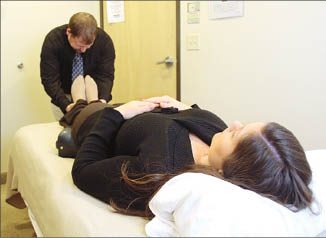
Home » Chiropractic clinic here strives to ease pain of pregnancy
Chiropractic clinic here strives to ease pain of pregnancy
Changes in hormones, posture seen as keys to pelvic discomfort

January 17, 2013
Certified chiropractic sports physician Steven Shirley says pregnancy can place painful demands on a woman's body, but those aches might be relieved by visiting a chiropractor or massage therapist when most pain relievers can't be used.
The practice that Shirley owns, Spokane Valley-based Spinal & Sports Care Clinic, actively started working with obstetricians and gynecologists in 2004, when, he says, it began to focus more on pregnancy-related pain.
Of the patients that come into the practice, Shirley says about 65 percent are women. "Several dozen" of the patients are pregnant, he says.
He adds, "Chiropractors believe pretty firmly that if you have a lot of back pain during pregnancy, you'll have a lot of back pain during delivery."
Shirley says visiting a chiropractor can ease pain during pregnancy as expectant mothers often aren't supposed to take drugs, even over-the-counter pain relievers.
He says when a woman becomes pregnant, her body produces a hormone called relaxin, which relaxes the joints in the pelvis. About 45 percent of pregnant women and 25 percent of women postpartum suffer from pelvic girdle pain as a result of changes in hormones and posture, he says.
"As the baby starts to grow, it changes the woman's center of gravity," Shirley says.
There are three main areas in the pelvis that are affected by pregnancy, he says: the piriformis muscle, which sits on top of the sciatic nerve; the sacroiliac; and the pubic symphysis, located at the front of the pelvis.
He says trouble with the piriformis muscle is common with pregnancy. The muscle, which can spasm and shorten, puts pressure on the sciatic nerve, causing pain that moves down the leg. Symptoms mimic a spinal disc injury. He says the key is to address the muscle and the joint.
"If you can release any tight muscles, the correction holds better," Shirley says.
He says he typically starts seeing pregnant patients midway through their pregnancies, but women can start experiencing joint pain in the first trimester, regardless of fitness level or body type.
"There are no hard and fast rules with the body," Shirley says.
He says patients who have a history of back pain can feel that pain worsen in the third trimester.
Two options are available to realign the sacroiliac joint: a traditional manual chiropractic adjustment, or a low-force adjustment, Shirley says.
For some women, such as those with a high-risk pregnancy, low-force adjustments are completed using foam blocks placed under the body, realigning the patient without any added pressure, as is typical during a traditional manual realignment, Shirley says.
Shirley says he likes to see patients come in both during the pregnancy and afterward. When mothers begin nursing, production of relaxin decreases, which can lead to alignment issues and pain within the pelvic joints, he says. A patient often can start to feel relief from post-pregnancy joint pain within one or two visits to a chiropractor, he says.
Mothers also may need realignment due to upper back, neck, and shoulder pain associated with nursing and the additional stress of repeatedly lifting large items, such as car seats, he says. Mothers typically come in needing realignment due to these stressors between two and three months after giving birth, he says.
Back, neck, shoulder, and pelvic pain can continue past the pregnancy for some if a woman doesn't get realigned, Shirley says. Even women who hold out on realignments for years after giving birth can still get relief if they experience pain; it just takes longer than a patient who comes in a few months postpartum, he says.
Pregnant patients oftentimes will pair realignment with a pregnancy massage, which works the muscles in addition to the joints, Shirley says.
Ashley Purdy, a licensed massage practitioner at the clinic, says she uses body cushions and wedge pillows to allow women to lie on their back or stomach. Once it becomes uncomfortable for a woman to lie on her stomach, or the area known as the pubic symphysis is aggravated, a body pillow is used to help the woman lie on her side.
She says massage sessions typically last between 20 and 30 minutes.
Purdy says it's common for someone to come back after giving birth for a massage to help relieve pain, echoing Shirley who sees patients come in after pregnancy for adjustments and realignments.
In addition to the chiropractic and massage services at the clinic, Shirley says patients are coached on proper lifting techniques and given tips on improving their core strength after pregnancy. Those exercises and techniques help the mother remain as pain free as possible after a visit, he says.
When the clinic opened more than two decades ago, garnering the support of doctors within the Spokane community was a challenge, Shirley says. The 22-year-old clinic now, however, gets regular referral traffic from a number of doctors.
Up Close
Related Articles




